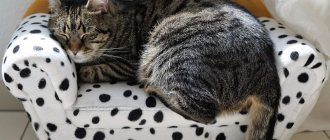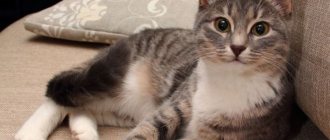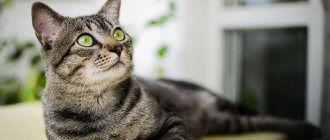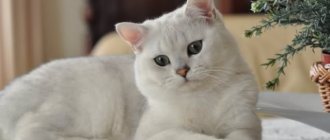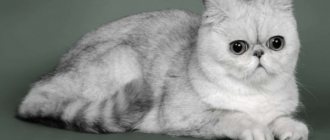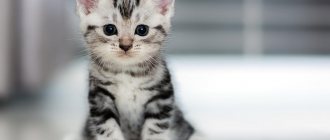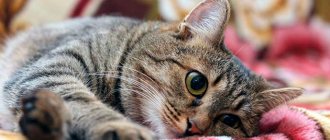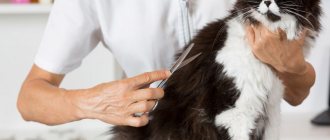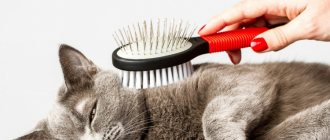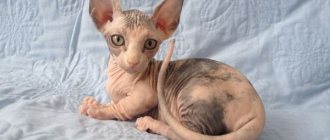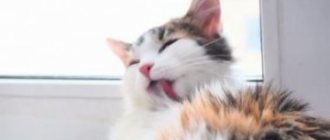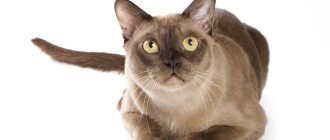04/11/2019 Drozd Nikolaevich Animals Pet lovers often prefer affectionate and cute cats. The “plush” breeds of cats, whose representatives look like soft toys, deserve special attention. If you are faced with the question of owning such an animal, it is worth figuring out what breeds you will have to consider in search of your four-legged friend.
Difficulties of care
Those wishing to purchase a plush cat should know that a thick undercoat can cause some difficulties in care.
During shedding (and for many domestic cats it lasts all year round, because their biorhythms are disrupted), fur flies all over the apartment. At first glance, it seems that if an animal is short-haired, then it has less hair. This is wrong. There may be even more in quantity, because... The undercoat is thick, but collecting it from the floor and objects can be very problematic - no matter how much you collect, it is still everywhere. However, it is worth noting that not all shorthaired cats shed. Among the listed breeds there are no non-shedding ones, but there are individual representatives that are distinguished by this quality.
For those who shed, there are several recommendations. Firstly, such cats need to be brushed regularly during shedding. Ordinary scallops and even furminators are not suitable for this. The first ones do not give the desired result, practically without combing the undercoat. The latter can damage even the living undercoat, thereby depriving the cat of its beauty. A special glove is best suited for plush cats. Secondly, during shedding, such cats can be bathed, which helps to wash out the lost hair.
Is it worth buying such a kitten? If short hair and ease of care are the only reason you want to settle on a kitten belonging to one of the listed breeds, you should refuse the choice. There will be difficulties in care! Otherwise, caring for a plush cat is the same as caring for any other cat.
If you want such a cat because you are crazy about its beauty and are ready to put up with some difficulties for its sake, welcome to the website of Scottish and British cats “Murkotiki”, where you will learn a lot of information about these breeds.
Scottish Shorthair Scottish Fold
Plush Scottish Fold kittens (Scottish short-haired fold breed) resemble fluffy balls from childhood. These kittens are also called bear cubs. They are perhaps the most prominent representatives of this phenomenon, which everyone calls the words “teddy cat”. The brightest ones are because, in addition to this quality, they also have ears folded along the skull, which is why the head becomes completely round.
Scottish fold, or Scottish fold
“Teddy” cats of the Scottish Fold breed are incredibly popular due to their appearance. This cat resembles a baby owl - its round face has almost no ears visible, and its eyes are large and round.
The breed originated in Scotland. In 1961, William Ross bought a cat and named her Susie. It was from her that the breed originated after several crossings. The first representatives of the Scots were not very attractive, but after crossing with the British Smoothhair, the cat acquired unique features, and the breed was recognized as independent.
However, the further path to recognition turned out to be very difficult. In 1971, thanks to research, they learned that the gene responsible for the shape of the ears often leads to deafness in animals. Geneticists prohibited the breed. But photos of “plush” cats have already spread around the world and won the hearts of cat lovers. Therefore, they began to look for ways to eliminate the problem, and in the end a solution was found: mating of two Scottish folds was prohibited, they were crossed with straights.
Breed standards:
- the body is medium in size, stocky, with dense bones and a voluminous chest, a wide back, the cat’s weight is 4-7 kg;
- the neck is short, massive, the tail is of medium length, tapering to the tip;
- the head is round;
- the paws are not long, muscular, thick, very similar to the legs of plush toys;
- eyes are large, round, yellow or green;
- short nose;
- the ears are small, with bends covering the shell, with a wide fit, turning forward;
- The fur is short and dense, reminiscent of plush, its color can be different.
Scottish fold character
By nature, cats of this breed are docile and calm. They cannot be called mischievous and active; they are rather intellectuals who do not allow themselves to hang on the curtains or rush around the apartment. It is more pleasant for them to lounge on the sofa near the owner, but there is no need for excessive affection.
The Scottish Fold likes people who respect their personal space. Although outwardly the cat looks indifferent, in fact it is loyal, it just does not show its feelings. This is almost the calmest cat breed in the whole world. Scottish Folds do not show aggression, do not get into conflicts, and rarely meow. These cats love to take interesting poses - stretching out their paws, standing in a column like meerkats, sleeping on their backs.
One of the characteristics of the breed is the inability to jump from heights, so Scottish Folds try to stay in the lower part of the room.
“Teddy” cats of the Scottish Fold breed are very friendly and become attached to members of the human family where they live. They are ideal four-legged friends for children, you can play with them, but you shouldn’t offend them, these cats have a vulnerable psyche.
Scottish Folds have a developed intelligence, they are excellent at learning commands and tricks, but they strive to do only what interests them. Their reluctance to follow anyone's lead is often interpreted as laziness.
Caring for a cat of this breed involves brushing the fur once a week, but you should not do this with a slicker brush.
American Curl
The American Curl is one of the most expensive cat breeds, first discovered in 1981 in California. These cute creatures are famous for their small protruding ears that resemble horns. Curls can be short-haired or long-haired, and their color comes in absolutely any color.
These cats have a graceful, medium-sized body and look quite well-fed. Females reach a weight of 3-5 kg, and males - 5-7 kg.
Representatives of American Curls are characterized by the following external signs:
- wedge-shaped head, wide ears turned at an angle from 90 to 180 degrees, large hazel-shaped eyes;
- rectangular body with a strong, straight chest;
- straight-set paws, strong neck, flexible and pointed tail.
American Curls do not have genetic diseases, despite the unusual shape of their ears. The curl gene of these animals does not have negative consequences for the health of the pet.
Find out all about the unusual American Curl cats.
Description and standard of the Ragdoll breed
Rag dolls surprise not only with their attractive appearance, but also with their size. The description of the breed indicates that male representatives can reach a length of up to one meter, and the largest can weigh up to 12 kg. It is not recommended to let cats go outside. Female representatives are much smaller - they reach 80 cm in length and weigh no more than 7 kg. They have blue eyes, white coat color, and the back of the nose is concave.
Colors
Thanks to selective breeding, three varieties of Ragdoll cats have been developed according to color type:
- Mitted. Similar to the third type of color, it has white paws, bib, chest and lower jaw.
- Bicolor. The ears, mask and tail are dark in color. The paws, chest, and belly are white.
- Colorpoint. Similar to the Siamese - the fur is light in color, and the paws, muzzle, tail and ears are dark in color.
Each color type has 4 shades: lilac, blue, chocolate, seal.
Features of care
A smooth-haired pet does not require much attention, unlike long-haired fluffies. However, it is also necessary to monitor the vital activity of such a cat. Even though they can handle their daily toilet routine on their own, they also need to be brushed periodically.
There are three types of shorthair cats:
- Smooth-haired cats. The least picky individuals. It is enough to comb your pet once a week. You can buy a special conditioner to improve the condition of the coat and maintain shine.
- Curly. It is better not to bathe cats with such fur. After the necessary water procedures, you should not comb your pet. Silk or suede is suitable for smoothing hairs and collecting dead ones.
- Plush. Pets with such a fur coat need medium-strength brushes. Rubber brushes and gloves will do.
It is recommended to remove dead fur once or twice a week. To do this, it is better to use a rubber brush or a special silicone glove.
Important! Inactive purrs definitely need to be combed out. The fact is that lazy pets often develop intestinal obstruction due to blockage by hair.
To prevent large amounts of hair from getting into your pet's stomach, you need to periodically use a brush. It is also recommended to give your pet a special malt paste. The product helps in dissolving lumps in the intestines.
This is interesting! Cats sometimes like to eat grass because it is enriched with vitamins and induces vomiting, thus clearing the stomach.
Smooth-haired cat breeds do not need to be washed regularly. Water treatments are only necessary if the wool is heavily soiled. Be sure to use specialized shampoos.
You need to check your ears and eyes daily. It is useful to trim the ends of the nails with animal clippers, which can be purchased at any pet store. There are regular nippers and those with limiters. On the second, you can set the acceptable size of claw trimming.
Short-haired cats also need vaccinations. Disease prevention and regular deworming help keep your pet in good health. Animals that periodically roam outside the home need deworming medications every three months. Homebodies can be treated for parasites only 2-3 times a year.
The diet of a short-haired cat should be nutritious and balanced. Proper nutrition strengthens bones, improves digestion and the condition of the skin and coat. In order not to suffer with homemade food, it is better to give preference to premium food. The ideal option is special food for the breed of your particular pet.
Important! Homemade food does not provide the cat with all the necessary vitamins and minerals. To keep your pet healthy, you need to include dairy products, fish, meat and vegetables in your diet in different proportions.
Be sure to monitor how much your cat eats. Overeating should not be allowed. Obesity will spoil the cat's proportions and have a negative impact on health.
Choosing a tray and filler for a short-haired pet is easier. With long hair, many types of litter stick to the fur, and the cat carries them throughout the house. Short-haired cats prefer sawdust, bentonite or silica gel.
How to care for cats
Short-haired breeds are suitable for lazy owners. These breeds shed significantly less hair than long-haired animals. However, short hair also requires careful care. These pets need to be brushed at least once a week. This is done so that dead hair is removed from the undergrowth and new hair grows in its place. It is recommended to do this using a special glove or comb. Caring for these breeds is standard, as for other animals:
- short-haired cats need a balanced, mineral-rich diet;
- if the kitten has a playful disposition, it is necessary to buy toys every month on which the animal would splash out its wild disposition;
- The list of required accessories includes: a tray, containers for food and drink, a scratching post;
Important! Bowls for dry and raw food should be different.
- You need to carefully choose the filler for the toilet tray. Many purebred animals have allergic reactions to sawdust and wood material. The best material for a cat litter box is silicone litter. It crumples perfectly when wet and does not stick to wet paws.
Although the short-haired species requires less grooming time, in other respects they are the same animals and family members as the rest. They need care, attention and care. In the absence of at least one of the above criteria, the life of the animal and the owner can become hell. The animal will demonstrate its dissatisfaction, be mischievous and do bad things to attract attention.
Litter tray
Tips for choosing and keeping good cats
In an era when families are limited to one child at most, a purebred (or non-pedigreed) kitten in the house is not a luxury: a friend for a child and an object of care for a lonely person
And since good cats are social animals, it is very important to follow the following recommendations for their selection and maintenance:
- You shouldn’t get a kitten if the apartment is empty most of the time - animals also get sick and die from loneliness;
- It’s difficult to explain to your pet that you came home from work and are tired - he’s waiting for you, he needs affection, take him in your arms, stroke him, listen to his purrs and make sure that after a hard day you can rest much faster;
- Explain to your child that the kitten is alive, it is not a toy that can be squeezed endlessly, dressed up in doll clothes, and, moreover, painted with cosmetics; no matter how affectionate the animal is, it needs personal space;
- if there are people in the house who are allergic to cat fur, then it is better to choose a Sphynx kitten;
- for single people, we recommend choosing an exotic cat who loves to sit in your arms;
- for children, one of the best options is the ragdoll, which treats children not only as a friend, but also as an object of protection;
- For apartments, experts recommend the Scottish Fold or Neva Masquerade, because these breeds are easy to comb and lose little hair;
- if you want to have a smart pet next to you, get a Maine Coon, but don’t forget that it needs a lot of space - it’s a big “cat-dog”.
To find out which cat breed is the most affectionate, watch the following video.
History of the origin of the breed
The history of the origin of the species began in the sixties of the last century. It contained many mystical details, and even included trials.
The variety of cats arose thanks to a woman from California, Ann Baker, who was breeding Persian cats. One of the cats, named Josephine, was a mixed long-haired breed (approximately Angora and Persian) and was the pet of a breeder's neighbor. Anne acquired Josephine's offspring, who had a calm disposition. She used it to breed a new breed.
The first kitten from Josephine was born thanks to her mating with a Burmese cat, which had a charcoal gray color. Carrying out further selection work, the breeder decided to create other shades for the “rag dolls,” namely white and brown. To do this, she attracted a Burmese cat with dark brown spots to breed.
When the breeder became famous, in an interview she admitted that Josephine was hit by a car and ended up in a hospital, where secret genetic experiments were carried out on her under the direction of the CIA. After this, the cat produced offspring that had low muscle tone, an increased pain barrier and an unusual calm disposition. Next, Anne carefully selected the calmest kittens for mating.
In 1965, the species was registered as the Ragdoll cat or Ragdoll ragdoll. Sometimes the name Red Gol appears in the media - it’s still the same breed, it’s just that it’s rarely found in other countries, it’s more of an American type of cat. This is why many people make mistakes in spelling and pronunciation of the name of the breed.
It wasn't until several decades later that the rag doll community had the breed compete in championships.
Exotic breed
These cats are loved by many for their appearance, friendly nature and activity. Externally, exotics look like charming toys: large eyes with a surprised expression, a flattened nose and “plush” fur.
The first representatives of the breed appeared in the 50s of the 20th century as a result of an unsuccessful experiment by crossing a Persian with an American shorthair. The breeders' goal was to change the color and make the bones heavier. As a result, the result was not at all what was expected, but the new species pleased the breeders a lot, and it was decided to continue breeding similar cats.
This is how a breed of exotic shorthair appeared, which, by its standards, repeated the parameters of the Persian cat, but was distinguished by unusual hair.
Description
Representatives of the Cornish look sophisticated and gentle, but behind this appearance there is a rather strong animal. Curly hair, strong bones and strong muscles, sharp claws and teeth - this is what distinguishes these cats.
Breed standards:
- The head is egg-shaped or triangular, the muzzle is wedge-shaped, the nose is Roman type, the cheekbones are high and clearly defined.
- The ears are wide at the base, cone-shaped, and set wide apart. The ends are rounded.
- The eyes are slanted, widely spaced.
- The neck is long and graceful.
- The body is strong and agile, the body is slender, the stomach is tucked, and the waist is noticeable.
- The tail is long and mobile.
- The limbs are fine-boned, muscular, and there are long toes on the paws.
- Soft and silky wool is the advantage of the breed. It fits tightly to the body, lies in even waves, and is curly.
- The color can be different, including Siamese (in this case the cat is called a Si-rex).
Peculiarities
The history of the appearance of short-haired cats takes us back into the depths of time, 60 million years ago, to the miacids, the ancestors of all predators on Earth, including cats. Over time, the weight of the animal became smaller, and about nine million years ago, animals appeared that were somewhat similar to modern felines.
Today, short-haired cats include breeds of cats whose hair does not exceed 4.5 cm in length. When compared to human hair, wool has a more complex composition. The follicles of an animal contain two types of hair at once: guard hair, which makes up the fur, and down hair (undercoat). The guard (integumentary) can have different lengths, thickness and rigidity. The thickest and longest fibers are called guides.
A guard hair may emerge from one follicle, surrounded by a whole tuft of fluff. It always lies on top, covering the down, thereby saving the animal from frost and precipitation.
The density of the undercoat and guard hairs depends on the climatic conditions in which the cats live. Northern animals have much thicker and warmer fur, with a lot of fluff. In the south there live cats with short hair that fits tightly to the body. Selected animals brought confusion into the natural pattern. Today, there are species that have no undercoat at all (Burmese), or even wool (Don Sphynx).
Rexes, contrary to the straight guard coat created by nature, are endowed with a wavy mutation. And the type of fur “brush” (some sphinxes have) looks like hard twisted wire.
Reasons for the great popularity of purebred shorthair cats
What attracts you to cats with smooth hair:
- Easy care. No need for long, daily brushing. The fur does not get tangled and gets dirty less.
- Beauty. Gracefulness is a distinctive feature of smooth-haired cats, regardless of physique and appearance. The large, imposing British breeds and the slender, fragile Cornish Rexes are equally graceful.
- Devotion to the owner. Each breed has its own character. But boundless love for the owner unites both independent, proud Siamese and affectionate Bombay cats that require increased attention.
Intelligence is another advantage: animals easily remember the rules of behavior. They are insightful, they sense the mood of the owner.
Short-haired cat breeds are the most common in the world
The variety of exteriors allows you to choose a pet with almost any coat color - black, red, blue. You can find the colors bicolor, tabby, brindle and many others.
Based on the type of coat, you can choose a pet with an unusual curly, close-fitting or plush coat.
Behavior of shorthair cats
Short-haired cats have different personalities: affectionate and calm or overly emotional and harsh. A kitten may start out quiet but become playful and a little aggressive as it matures.
Approximate character traits of different breeds of shorthair cats:
- the British are calm and slow (like the Scots);
- the European is independent, but is attached to the house and owners;
- Toygers will delight you with playfulness and fun;
- oriental will amaze with its emotionality;
- Siamese cats are very sociable and often show their temper;
- Egyptians are independent;
- Russian Blue will delight you with accuracy and restraint;
- exotic is suitable for calm and affectionate people.
Finding a short-haired friend is easy. You can choose a breed that gets along with children and other animals. Or adopt a cat who loves to “chat” with its owners. There will always be a gentle pet or a capricious predator. Everyone will find a short-haired cat to their liking.
Which cat is right for you?
Which pet is better to choose depending on its character:
| Expectations from a pet | Breed |
| Active | Ural Rex, Japanese Bobtail, Savannah, Oriental, Burmese, Asherah |
| Playful, but in moderation | Scottish Fold, Snowshoe, Russian Blue, Mekong Bobtail, Burmilla, British Shorthair |
| Calm, phlegmatic | Exotic Shorthair |
Smooth-haired cats are faithful, devoted pets.
They do not require complex care and are most often hypoallergenic.
Short legs
Oddly enough, “short legs” is a sign of thoroughbred pets, but all cats with similar limbs were bred exclusively artificially:
Munchkin
short straight legs (the hind legs may be slightly longer than the front ones), a medium-sized body with well-developed muscles, a thick neck and a wide wedge-shaped head, short or long hair.
more details
Skookum
skokum
short but strong legs (the front ones are slightly shorter than the hind ones), a compact and dense body with rounded contours of the head and a long tail of medium thickness, curly hair (can be short or long).
Napoleon
neat short paws, a small but strong body with massive bones and a long tail, a rounded head with a flattened muzzle and huge round eyes separated by a short nose, short or long, but always thick hair.
Bambino
short but muscular legs, a stretched oval-shaped body with a wide chest and a long thin tail, wide-set large ears (slightly tilted forward) located on a medium-sized head, a visible lack of hair (although light corduroy fluff is allowed).
more details
Minskin
short legs (of the same length below and above the knee joint), a rounded head with large, open and seemingly “alert” ears, thick and dense, but short hair growing in islands (on the head, ears, limbs, tail) almost on the “bare” body
more details
Description of “plush” cats of an exotic breed
The appearance of representatives of this breed is simply unique, and it is simply impossible to confuse them with any others. The animals are distinguished by their strong build and rounded body shape. Exotics' eyes are round and large, set wide apart. The coat is thick and “plush”.
Description of appearance:
- the skull is large, wide, the head is massive, the neck is short, strong, the nose is short, neat, the cheeks are full, the chin and jaws are strong;
- ears are small, set wide apart, with rounded tips;
- the eyes are large, round and expressive; it is for the expression of the eyes that the breed parameter is noted as “sweet expression of the muzzle”;
- the body is stocky, muscular, the chest is wide;
- the paws are short, strong, with tufts of hair between the toes;
- the tail is short, fluffy, the tip is rounded.
The fur of exotic cats is like plush. Its length is average, the color can be any except light beige and cinnamon.
By nature, exotics are friendly and get along with any family members. However, they need time to get used to new people or animals. Once in a family, the cat will first observe the behavior of its owners. Having looked closely, he will choose the main person to whom he will be devoted, like a dog, and will be simply friendly with everyone else.
How to choose a kitten
If you want to purchase a purebred real British dog, then you should pay attention to the characteristics of the breed (the standards of which were approved back in 1982). These standards include:
These standards include:
- strong muscular body;
- powerful legs, like those of an exotic;
- massive round head on a short powerful neck;
- straight, wide and slightly shortened nose, without a stop, but pronounced towards the forehead;
- round muzzle without indentations (pinch is not allowed), well-developed chin, round, wide-set eyes;
- rounded, wide-set ears (the height of which should not exceed their width);
- straight (medium in length, but wide) tail with a rounded tip;
- short, dense wool with a plush-like texture;
- fold of skin around the head.
A British kitten's walk should be full of vivid impressions
In addition to the characteristics of the breed, you should definitely pay attention to the documents and living conditions of the kittens. If the breeders do not treat the animals properly (the place is not clean, has a characteristic unpleasant smell, the animal is given cheap food for food, it is kept in a cage), turn around and go to another place
If the breeders do not treat the animals properly (the place is not clean, has a characteristic unpleasant smell, the animal is given cheap food, it is kept in a cage), turn around and go to another place.
It is worth paying attention to the parents of the kittens (you will be able to understand what your “plush” will be like). Look at color, weight and other features
If your Briton is a ginger cat, then his offspring will be the same.
Please also pay attention to the fact that kittens should not be purchased before 12 weeks of age, as they still need maternal care
There must be something edible in this basket, well, at least a sausage!
Character
British Shorthair cats truly live up to their name: thus, living with a representative of this breed, you will live next to a small, reserved Briton, this is the true behavior of an aristocrat, you should not be surprised if your pet does not respond to the usual “kiss-kiss-kiss” ", for many British people this is even a little offensive.
These are very affectionate and loving cats, but they do not require much attention and feel comfortable alone.
British shorthair blue
These cats will always find something to entertain themselves without causing pogroms and races. Even if the kitty gets playful, she will always calculate her path so that everything remains safe and sound. But still, the British need to be educated, and this needs to be done from early childhood, otherwise retraining the pet will be extremely problematic. The plush beauties are very smart and clean, they quickly understand where to sharpen their claws and where to go to the toilet. There were cases when a Briton was taken out of town and the animal suffered from the inability to visit its toilet place.
The British are very devoted to their owners, friendly with them and quite loyal. They perceive the family in which they live as a clan, without singling out their favorites from it. Quarrels and discord in your home are extremely painful and can cause illness due to the current situation.
Temperament of an exotic cat
Exotic shorthair cats have an exceptionally soft, kind disposition, which largely replicates the character of the Persians. But if Persians are the calmest cat breeds, then exotics are more mobile and active than their long-haired counterparts.
They know how to combine different aspects of temperament and be at the same time lively and restrained - exotics love to sit quietly on the sofa or spend time curled up on the owner’s lap, but at the same time they are not averse to active entertainment and games. A peaceful and calm exotic cat, the price of which will be discussed below, needs attention from the owner.
Being alone, a cat can become sad and depressed, this often leads to destructive behavior in the pet.
To prevent such manifestations, the owner can purchase various playhouses and exercise equipment for the cat, with which the pet will have fun in the absence of household members. The playful exotic exhibits tolerance towards other animals - it can coexist peacefully with cats and non-aggressive dogs. Do not forget that in the veins of exotics flows the blood of not only calm and balanced Persians, but also playful American shorthair cats. From these ancestors, the exotics received hunting instincts, curiosity and mischief. Therefore, you should not be surprised if such a cute pet as Snoopy, whose cat breed is popular and in demand, brings back a caught mouse or other prey.
Nuances of care
If a cat with long hair moves into a family, there will be a lot of care for both it and the apartment. In this regard, it is easier with short-haired animals, but they shed no less than their counterparts - they just have shorter hairs. In the wild, animals molt twice: in preparation for winter and in preparation for summer. In domestic cats, due to a comfortable constant temperature, the “deceived” body malfunctions and sluggish molting occurs throughout the year.
Active shedding of an animal's fur can be affected by illness, stress, old age, and poor nutrition. The appearance of a large amount of fluff in a house with a young cat should be an alarming signal for the owner. The physical or psychological health of the pet should be checked.
A short-haired cat will also have to be brushed, only less often, about once a week. There are a number of reasons why you should do this.
- Hair licked by a cat can clump in the intestines, interfering with the digestive process. If you do not help to get rid of dying hair in a timely manner, the animal will have to be given a gel to absorb it.
- The brush perfectly massages the skin, improving its blood supply, and therefore the quality of the coat.
- Many cats love the combing procedure; at this moment, a special emotional contact arises between the owner and the animal.
You can remove hair from an animal using special combs, brushes or a silicone glove with teeth purchased at a pet store.
To do this, you should carefully brush the brush two or three times from the pet’s scruff to the tail, and then do the same movements in the opposite direction. Having finished working with the back, you need to carefully comb the sides and stomach
Washing a short-haired cat should be done as a last resort. But it is necessary to periodically take care of the ears, eyes and paw pads. This is done using cotton swabs, swabs soaked in boiled water, a weak solution of manganese or a decoction of herbs.
The owner is also responsible for the health of the animal. It is necessary to periodically show the cat to the veterinarian for preventive purposes and monitor the vaccination record. Give your pet deworming pills once every three months, even if he doesn’t go outside.
Many cats are unpretentious in their diet and eat whatever is given to them. But a proper balanced diet will help keep the animal healthy for many years.
Shorthair cats are as beautiful, smart and talented as all the cats in the world, but there is a little less hassle with their fur.
For information on the characteristics of short-haired cat breeds, see the following video.
Persian cat
These are quite massive cats with a soft expression on their faces. The head is decorated with a short snub nose, the lobe of which is colored in accordance with the main color of the animal, and round, slightly protruding eyes. The long, thick hair gives the roundness and smoothness of the body curves.
Persians can be white, gray, cream, blue, red, lilac, red and black. Males reach a weight of 7 kg, and females - 5. The average life expectancy is 11-15 years.
Thanks to selective selection, Persian cats are the most domestic breed, not adapted to street life. They meow little, but love to communicate, especially with children. It is not difficult to teach them the rules of behavior, they quickly get used to the toilet and can even be trained.
Due to their excessively long coat, Persians require regular grooming procedures: daily brushing, using a furminator once a week, and bathing once every 2-3 weeks.
Learn more about the beautiful and fluffy Persian cats.
The most interesting shorthair cats
Interesting and unusual smooth-haired cats include the following breeds:
- Asher.
- British Shorthair.
- Burmese cat.
- Burmilla.
- Mekong Bobtail.
- Oriental cat.
- Russian blue cat.
- Savannah.
- Snow-shu.
- Ural rex.
- Scottish fold cat.
- Exotic shorthair.
- Japanese Bobtail.
Asherah
This is a large cat about a meter tall, weighing up to 15 kg. The animal's grace and appearance resembles a leopard, and its character is kind and affectionate.
Asherah
According to breeder S. Broduy, genes from the African Serval, domestic and Bengal cats were used to breed Ashers.
This is the most expensive and most scandalous breed of cats in the world. Lifestyle Pets sells kittens for $25,000. At the same time, Ashera is not recognized by any felinological society.
British Shorthair
Independent, sedate aristocrats - the British - are famous for their good character, intelligence, and calm behavior. They get along well with other pets and children.
Be sure to read:
Cat breeds similar to Siamese: 10 most popular, what are the similarities and differences
They value the owner’s personal space, they will not bother you or beg for affection, but they will not allow themselves to be squeezed either.
The British are strong, muscular cats, with an average weight of 7 kg. The standard regulates several types of color - plain, two-color, striped (as in the Whiskas cat food advertisement).
Burmese cat or Burmese
Animals of this breed are medium in size, strongly built, weighing up to 6 kg. They are distinguished by a compact body, long graceful paws, a rounded head with large eyes, a short nose and medium-sized ears, and a long tail.
Fur without undercoat, uniformly colored. The lower part of the body is lighter than the upper. Popular colors are black, blue, chocolate, cocoa with milk.
Burmese cat or Burmese
By nature, Burmese are affectionate, devoted animals that need the attention of their owner.
The Burmese cat has two subspecies - European and American, differing in the colors fixed by the standard.
Burmilla
The Burmilla is a young British breed obtained by crossing a Burmese cat and a Persian chinchilla cat. The animals are medium-sized, proportionally built, weighing up to 7 kg.
Burmilla
The coat fits tightly to the body, the hairs are tipped. It is formed by shades of red, cream, silver and purple. The undercoat is of medium density, golden or silver.
Burmillas are inquisitive, kind, affectionate animals that cannot stand being alone.
Mekong Bobtail
Graceful, yet strongly built, Mekong Bobtails are reminiscent of Siamese cats in color. Their distinctive feature is a short, seemingly broken tail.
Playful, inquisitive, devoted pets to their owner, ready to travel with him. They are smart, active, and easy to train.
When confronted, Mekong Bobtails bite rather than scratch like most cats.
Oriental cat
Slender, thin-boned Orientals are distinguished by narrow shoulders and hips, while the body is muscular and the neck is long. They have large, wide-set ears and huge, almond-shaped, slightly slanted eyes.
The fur is short, devoid of undercoat, and lies tightly to the body. Colors can be of different colors, spots and stripes are allowed.
Oriental cat
Cats are very energetic, constantly on the move, playful, and talkative. They like to be the center of attention. They need human company and are sensitive to the owner’s mood.
Russian blue cat
Aristocratic animals with a soft, obedient character , loving human company, but not allowing liberties with themselves. The Russian Blue is calm, sedate, and not very playful.
She has an elongated, medium-sized body, strongly built. The emerald-colored, almond-shaped eyes are set wide on the wedge-shaped head.
Be sure to read:
American Shorthair cat: photo, price and character
The fur coat is soft with a small undercoat and feels like plush. The color is uniform blue with a slight silver tint.
Pets do not like strangers ; when guests arrive, they prefer to sit in a secluded corner.
Savannah
Large, athletically built Savannahs are miniature versions of cheetahs. Long slender legs, an elegant flexible body, and the spotted color characteristic of wild animals are their distinctive features.
Savannah
Cats are active , take a leadership position in relation to other pets, are attached to the owner, and may not like strangers. They would rather go on a trip with their owner than remain under the supervision of friends.
They can hardly be called affectionate; this quality is inherent in kittens, but goes away with age. Savannahs get along well with small children and love to participate in their games.
The breed was developed in the USA in the 80s of the 20th century. The ancestors of the savannah are the Siamese cat and the African serval.
Snow-shoe
Cats are playful, active, need the attention of their owner, and do not tolerate loneliness well. They sense the owner’s mood and are ready to support him in difficult times or share his joy.
Snowshu are loyal to their owner, intelligent, and capable of following simple commands.
The animals are medium in size, have a muscular body, and weigh about 6 kg. The standard regulates the color point color. White spots on the face, chest, and white “socks” on each paw are required.
Snow-shoe
Snowshoes love water and enjoy swimming and swimming in open bodies of water.
Ural rex
The Ural Rex is an indigenous breed ; its special breeding began in the late 80s of the 20th century in the Sverdlovsk region. She is distinguished by her friendly, affectionate disposition, playfulness, and activity.
Animals practically do not shed their fur, with the exception of seasonal molting.
The body is muscular and short. The paws are slender, not very long. The head is wedge-shaped, the eyes are large and slanted. Their color matches the coat color. The fur is dense, curly, and the curls are elastic.
The breed is considered hypoallergenic.
Scottish fold cat
Good-natured cats who love attention and games with humans. Animals do not tolerate loneliness well and miss all family members. They are smart, keenly interested in what is happening in the house.
The calling card of these Scots is their flattened, folded ears.
The calling card of these Scots is their flattened, folded ears.
Visually, they seem to be a continuation of the rounded head. The body is medium in size, legs are short. The fur is dense, like plush, of medium length. The standard allows for color options - solid, saturated, lightened, with a pattern.
Many breeders note the stubbornness of Scottish Fold cats.
Exotic Shorthair
Calm, peace-loving, lazy people who value comfort - this is how you can describe the character of exotic shorthair cats.
They do not like active games, heights, noise. Animals are faithful to their habits and value the established way of life in the family.
Be sure to read:
What are the different colors of Bengal cats?
Males and cats are stocky, with a large body. The head is large and round with huge expressive eyes and small ears. The coat is thick, dense with undercoat. Because of this feature, the pet needs daily brushing.
The breed was developed in the USA by crossing an American shorthair cat with a Persian cat.
Japanese Bobtail
Animals of this breed are smart, intelligent, and playful. They love water and swim happily. The pet can be trained; it can easily master the “fetch” command.
Japanese Bobtail
The cats are medium-sized, muscular and long. The head is shaped like an equilateral triangle, the eyes are large and alert. The tail is short, may be kinked or resemble a pom-pom.
In Japan, bobtail cats are considered symbols of good luck.
The character and behavior of the British
The British Shorthair has a gentle, calm disposition and is very attached to its home. She represses the expression of her emotions to such an extent that she may seem cold, but her true feelings are simply not shown clearly. In fact, her attachment to her owner or mistress is so deep that a British cat can become a person’s best friend and show this quality precisely at the moment when people most need support.
The British Shorthair is renowned for its excellent health
The plush cat, as he is now called by fans of his unusually pleasant-to-touch fur, has a far from plush character.
The British cat is independent, proud, cold and aristocratic, with a developed innate sense of self-esteem - the inherent qualities of this royal cat.
The English king among his subjects is as sweet, polite and tolerant of others when they are sweet, polite and loyal to him, as British cats are to their surroundings.
Character and education
The Ragdoll breed is one of the best companions. Most of all, the character of a cat of this species resembles dogs - they are so attached to their owner that they constantly chase him from room to room, can understand nuances of speech, and are easily accustomed to the litter box.
But their excessive calmness and friendliness can turn into a disastrous outcome for them if there are small children at home who decide to cuddle them, because the ragdoll will not mind.
The Ragdoll cat completely trusts its owner. If he leaves her for a long time, the latter will become depressed. Accordingly, when traveling to another city, it is advisable to take your pet with you, especially since Ragdolls adapt very easily to new conditions.
The Ragdoll breed is considered to be one of the laziest. The pet's activity is average. Their playfulness, like that of kittens in adolescence, remains until old age. To prevent your pet from being bored and lonely without you, you should accustom him to toys from childhood.
Health
Considering the efforts of the breeders, the British were in good health.
These cats are prone to obesity and tearfulness, but otherwise are susceptible to the same diseases as cats of other breeds.
Characteristic diseases
If you do not properly care for your pet: feed it poorly, do not provide proper care and do not take care of its mental state, then it may develop one of the following diseases:
- KSD, cystitis, nephrosis and other diseases of the genitourinary system;
- Bronchitis, rhinitis and other respiratory diseases;
- inflammation of the spinal cord and neuroses;
- stomatitis, pharyngitis, ulcer
- and many other diseases.
British kittens are excellent camouflages
Vaccinations
The Briton needs to get some vaccinations, before which it is important to give the kitten anthelmintic drugs
- Produced in 10-12 weeks. This is a rabies vaccine (trivalent). It repeats after 3 weeks.
- The rabies vaccination is given after changing teeth and is repeated annually.
British cat helps prepare for Easter
All manipulations must be noted in the passport. When buying a kitten, you need to check them
Cornish Rex
This amazing breed of cats first appeared in England in the 50s of the 20th century. It is distinguished by an elegant physique, an expressive muzzle and dense curly hair - the main feature of the breed. The soft and silky coat has even curls without bald spots and flows in smooth waves of varying depths.
The color of cats can be black, white, blue, cream or red. There are also bicolor colors, the classic tabby shade in various colors and smoky colors. There may be white markings on the coat.
Cornish Rexes are very sensitive and affectionate animals that need attention. They are endowed with high intelligence, do not tolerate loneliness well and are excessively clean.
We offer you to view the full article about Cornish Rex cats.
British Shorthair
This cat breed is quite popular now. It was bred in England in the 19th century by crossing Persian and English domestic. When “plush” British cats began to be shown at exhibitions, they were recognized as the best. The aristocratic public indulged these cats with their attention. And later the breed began to be in demand in other countries.
Today, cats with “plush” fur of the British Shorthair breed are so common that they can be found in almost every home.
Longhair
Burmese cat
Burma, as these cats are called for short, has the luxurious fur coat of the Persians and the original color of the Siamese. There are many legends and tales wandering around the breed and they are called “sacred”. It is difficult to say what is true and what is fiction, however, the Burmese are truly distinguished by their “holy” character.
They are playful, but not dirty, active, but in moderation. They do not impose their communication and agree to wait until the owner has time to communicate. The Burmese cat gets along with children, but does not like excessive noise and tense environments.
Neva Masquerade
They are called Siberians with Siamese sophistication; cats and cats of this breed are beautiful, large and very colorful. But this is by no means a merit of the efforts of the breeders, but the result of an accidental love between a Siberian cat and a cat with a Siamese color (it is not known for sure whether she was Siamese or Himalayan).
The Neva cat is a long-liver, its fur does not cause allergies and does not require painstaking care. She has a certain charisma - she loves to show off, but she is distrustful of strangers. Adapts perfectly to new conditions and loves his family.
Norwegian Forest Cat
Once upon a time, this large, colorful animal with long luxurious hair lived in the Norwegian forests. Naturally, this determined his hunting qualities and endurance, but selection work turned the cat into a cute domestic creature that retained high intelligence and beautiful appearance.
The Norwegian Forest cat is suitable for indoor keeping; it is very balanced and calm. He loves to communicate, but sometimes he doesn’t mind being alone. Finds a common language with other pets and is good with children.
Persian cat
Cats of this breed are hard to miss - after all, they have an extravagant appearance - a wide muzzle with a flattened nose and the most luxurious fur. The breed has undergone a number of changes, not always positive, but today it has no flaws, and its representatives are healthy and active.
The Persian cat is an ideal companion that does not like loneliness and is not suited to living on the street - only with a person does it feel calm and confident.
Ragdoll
A young amazing breed of cats that can completely relax all their muscles, which is why its name translates as rag doll. These are quite large animals with beautiful fur. Born with white fur, after a year and a half it acquires the most incredible colors.
Ragdolls are absolutely sociable cats; loneliness is difficult for them, and they are ready to follow their owner anywhere. They are phlegmatic, they love to lie around, but they also don’t mind playing, especially with children.
Siberian cat
This is a native breed of Siberia and is believed to have descended from wild forest cats. Stocky, large (cats weigh up to 12 kg), fluffy - cats of this breed cannot leave anyone indifferent.
The Siberian cat has a developed hunter instinct, therefore, even if it gets lost, the pet will not disappear and will be able to provide itself with food. This quality also helps rid the house of rodents. These pets are unpretentious in all aspects of life, intelligent, but somewhat reserved.
Skitish fold (Scottish fold cat)
Fold cats, brought from China to Europe, were crossed with local breeds - this is how the Scottish Fold cat or Skitish Fold appeared. The animal is of medium size, strong, harmoniously built body with muscular legs.
The short coat is elastic and soft, adheres to the body and comes in a variety of colors. Solid color fur: white, cream, fawn, chocolate, cinnamon (a type of brown), lavender, black and blue. Tabby (pattern): spotted, striped, marbling. Bicolors (double color), tortoiseshell colors, and chinchillas are also characteristic of the Skitish Fold breed.
The Scotsman's eyes are round, open, set far apart, their color is in harmony with the color of his fur coat. They are light yellow, amber, emerald or blue.
The Scot's calling card is his ears, small, drooping forward and down. It is for these unusual ears that the breed got its name - Fold.
It is difficult to find a more flexible and affectionate pet. Distinguished by their friendly and calm character, cats of this breed enjoy life and get along well with all family members and other animals. Active and playful kittens become balanced and sedate as they grow older.
But the hunting instinct of this breed is poorly developed. Cats are absolutely not aggressive and cannot become rodent exterminators.
